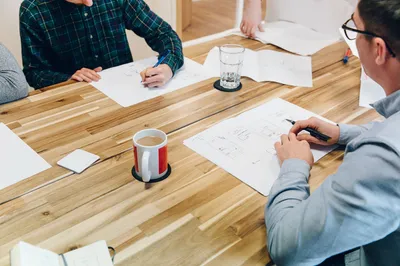Why is our concept conversion rate so high?


Here at Shape we set the bar high in terms of work output, and look to create awesome relationships with every client from the get go. But why is our web design concept rate so high? Let's take a look at some elements of the process...
Let's imagine the project has been explained. The requirements are understood. The budget has been set. What happens next?
First we talk.
It's important to understand what the clients expectations are. What they personally like in terms of design and development. And what they perceive to their brand to be in at least 12 months time.
The biggest factor to understand is how the client digests current trends. Sometimes new features, approaches, creativity and change can be too much for some clients. Everybody is different and it's important to understand that design is about opinion. A website should not only target the audience, it should reflect the brand ethos and personality. And the company director should be proud to show it to friends, family and clientele.
Once we've got a good idea of what the clients perceives to be 'good design'. We jump straight into references...
So, what are references?
We show the client websites that are relevant to the project. Not necessarily by industry or sector, but by specific items whether that be in design, development or usability. For example: we may show a website that uses a nice animation, or has an usual navigation system, or a specific choice of font. We explain our thinking behind each website and just listen to the clients feedback. Whether they like all the references, some, or none at all - this is very important in terms of web design process.
This is still a discussion, and can last as long or as little time until both parties are happy with the direction in which the project is going.

Let's design.
Knowing the brief, the requirements, the expectations, and the clients opinions surrounding web design and brand perceptions... we can finally open photoshop and start to design.
We design 2 or 3 pages based on the brief (sometimes taking context from their existing site) and use InVision to present to clients who prefer to see something immediate or who are further afield (we have clients all over the world).
Some clients prefer to meet face to face and discuss the concept so that myself or one of my team can explain their thinking. We'd prefer this approach but realise it's not always possible and some clients prefer to work in different ways.
Once the concept has been delivered, we talk again, getting an initial reaction to the design, the theory behind it and how well we've executed the brief.
At this stage the client is able to make as many changes as they wish until happy. Or tell me they hate it and want me to start again. But in the 12 years I've been a designer, this has only happened a couple of times and that's probably my fault for skipping the references phase.
So on the whole, the majority of our concepts get signed off first time, sometimes with no changes, others with minor tweaks. This all comes down to the preparation and time spent with the client asking questions and understanding their thinking before baffling their brains with current trends, UX theories and technical jargon. I find that most of the technical stuff can be explained to the client at the concept presentation, rather than in the research stage.
Long may this continue and thanks to all our clients for being so bloody lovely.
To view our latest please visit our Dribbble account.
Co-Founder of MadeByShape. Most of my blogs are about business related aspects, not just web design.